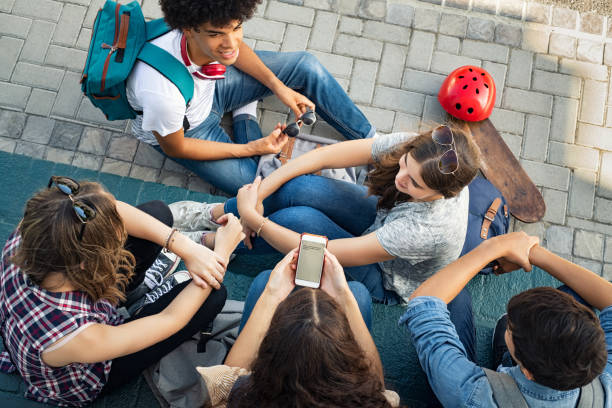
As technology advances, the younger generation increasingly relies on gadgets for tasks once learned through traditional methods, eroding vital skills that defined generations before them and shaping their future differently.
The Rise of Modern Gadgets
It’s a chilly morning in the bustling city, and the young woman carefully pulls her smartphone out of her bag. With a swift motion, she taps on a weather app to check the temperature for the day. She scrolls through social media feeds, orders her coffee, and quickly programs her commute on a navigation app. In her world, everything is optimized, organized, and fast. This is how most young people interact with their environment: through a screen, relying on technology to complete everyday tasks.
Once upon a time, these very activities—checking the weather, getting directions, even ordering coffee—were skills passed down through generations. From forecasting weather based on the wind’s behavior or using paper maps and a compass to navigate the world, these skills were once mastered by hand. Yet, with the growing reliance on gadgets, many of these traditional practices have begun to fade. The younger generation, tethered to their devices, is increasingly losing touch with the traditional skills that were once essential to daily life.
A Shift in Learning: From Practical to Digital
There was a time when learning was hands-on, driven by curiosity and necessity. Children learned how to bake from their grandmothers, how to use a needle and thread from their mothers, and how to navigate the world with a compass from their fathers. These skills weren’t just about practical knowledge;they were deeply ingrained in cultural identity and family heritage. The kitchen was a place of learning, and the streets were classrooms where one could learn the art of map reading or start a conversation with a stranger to learn new insights.
But today, the dynamics have changed. Instead of reaching for a cookbook, young people search for the recipe online, skipping the trial-and-error process that often teaches patience and resilience. Instead of memorizing a route or understanding the signs of changing weather, they rely on digital maps, apps, and algorithms. The transition from learning through experience to learning through digital devices has altered how we acquire knowledge—and what knowledge we value.
The Impact of Technology on Physical and Mental Dexterity

When a young person uses a smartphone to learn how to cook a dish or relies on a GPS to find a destination, they bypass the process of thinking critically, analyzing, and solving problems in a hands-on way. The result? A decline in practical problem-solving abilities and a loss of fine motor skills that come from tasks like handcrafting, cooking from scratch, or repairing items. This shift from manual labor to automation, once a symbol of advancement, now represents a devaluation of traditional skills that kept us connected to our physical surroundings.
Even when it comes to communication, the reliance on gadgets is evident. Letters, once handwritten and filled with personalized touches, have been replaced by text messages, emails, and social media chats. The art of crafting meaningful, well-thought-out written communication has taken a backseat to brief, emoji-filled exchanges. In a world where everything is instant and effortless, traditional skills like letter writing, reading a map, or sewing clothes are slipping away, leaving behind a generation that is often disconnected from the rich, tactile nature of traditional life.
The Erosion of Cultural Heritage
With every swipe on a screen, we lose a piece of our cultural fabric. Many traditional skills, such as hand weaving, pottery, and embroidery, are on the brink of extinction. This is especially evident in rural communities where younger generations, raised on technology, are increasingly uninterested in learning trades passed down for centuries. Why would they bother learning how to repair an old chair when they can simply order a new one online? Why would they weave intricate patterns when they can purchase a mass-produced textile for a fraction of the price?
The irony is that these traditional crafts weren’t just practical; they were cultural symbols of history, identity, and community. They carried the stories and wisdom of past generations, passed down through practice and storytelling. In today’s world, with rapid technological advancements, those stories are being forgotten, and cultural ties are slowly dissolving. As technology continues to replace traditional practices, the rich, sensory experiences tied to these arts begin to fade away
The Paradox of Convenience It’s important to acknowledge that modern gadgets and technology have brought undeniable conveniences. Tasks that once took hours now take minutes. Communication across vast distances is instantaneous, and work can be done remotely from the comfort of our homes. For many, this convenience is a boon—a tool for personal growth, work efficiency, and connectivity. The benefits of technological progress are evident in the ways it has revolutionized our lives.
However, there’s a paradox to all this convenience. While technology offers ease, it also strips away the richness of direct experience. The process of building something with one’s own hands, navigating by memory, or learning a skill through trial and error adds layers of meaning that gadgets simply cannot provide. Technology may be making our lives faster, but it is also making them shallower in terms of hands-on experience.
A Generation Divided: Embracing Change or Rejecting It?
The younger generation finds themselves caught between two worlds: one that values the efficiency of technology, and one that longs for the knowledge and tactile skills of the past. Many young people are aware of the value of these lost arts but feel they have no place in the fast-paced world they inhabit. To them, mastering a craft like knitting or woodworking seems irrelevant when faster, more efficient solutions are readily available at the tap of a screen.
On the other hand, there is a growing movement of young people who are beginning to rediscover these lost arts. Many are looking to preserve their heritage by learning how to make things with their own hands, whether that’s through sustainable fashion, DIY home repairs, or cooking from scratch. The rise of the “slow food” movement, for example, is one such effort to revive the tradition of cooking with local ingredients and taking the time to prepare meals thoughtfully. It’s a return to something more deliberate, a counterbalance to the frenzy of the digital world.
Looking Forward: How to Balance Tradition with Technology
So, where does this leave us? Can we balance the benefits of modern technology with the preservation of traditional skills? Absolutely. The key lies in finding a way to integrate both worlds. Technology should not replace traditional skills; rather, it can be used to complement them. Online platforms can provide access to tutorials on traditional arts, while gadgets can offer new ways of learning these skills faster and more efficiently.
For instance, a young person can learn how to sew on YouTube or use a smartphone app to create their own patterns, and then, through practice, master the art of hand-stitching or quilting. In the same way, people can embrace digital tools to enhance their experience, but not forget the value of time spent honing physical abilities and reconnecting with the hands-on traditions of our ancestors.
Conclusion: A Call to Reconnect
The world is changing at an unprecedented rate, and with it, so are our skills. Technology is not inherently bad; it has transformed our lives in countless positive ways. But in our rush to embrace the digital revolution, we must remember that there is value in the old ways—the ways that connected us to our heritage and gave us a deep sense of purpose and community.
It is time for a renaissance of traditional skills. Let’s reclaim the art of letter writing, the wisdom of navigation by the stars, and the beauty of handcrafting. Let’s use technology to preserve and share these skills, not to replace them. After all, the future will be richer if it is built on the strong foundation of both the old and the new.
Q&A: Reconnecting with Traditional Skills in a Digital World
Q: How has technology impacted traditional skills among the youth?
A: Technology has significantly diminished the need for many traditional skills by making tasks faster and more efficient. This has led to a decline in skills like cooking from scratch, map reading, and handcrafting.
Q: Can technology and traditional skills coexist?
A: Yes, technology can complement traditional skills. Online resources, tutorials, and apps can help teach and preserve traditional arts, while digital tools can enhance the process of learning and creating.
Q: What are some examples of young people rediscovering traditional skills?
A: Many young people are embracing the slow food movement, sustainable fashion, and DIY home repairs. These efforts reflect a desire to reconnect with hands-on, traditional ways of life.
Q: Why is it important to preserve traditional skills?
A: Traditional skills are vital for cultural heritage, personal fulfillment, and practical problem-solving. They teach patience, resilience, and creativity—qualities that are often overlooked in the digital age.
Q: How can we encourage the younger generation to value traditional skills?
A: We can encourage young people by making traditional skills more accessible through modern technology, highlighting their cultural significance, and showing how they complement the fast-paced, digital world we live in.
